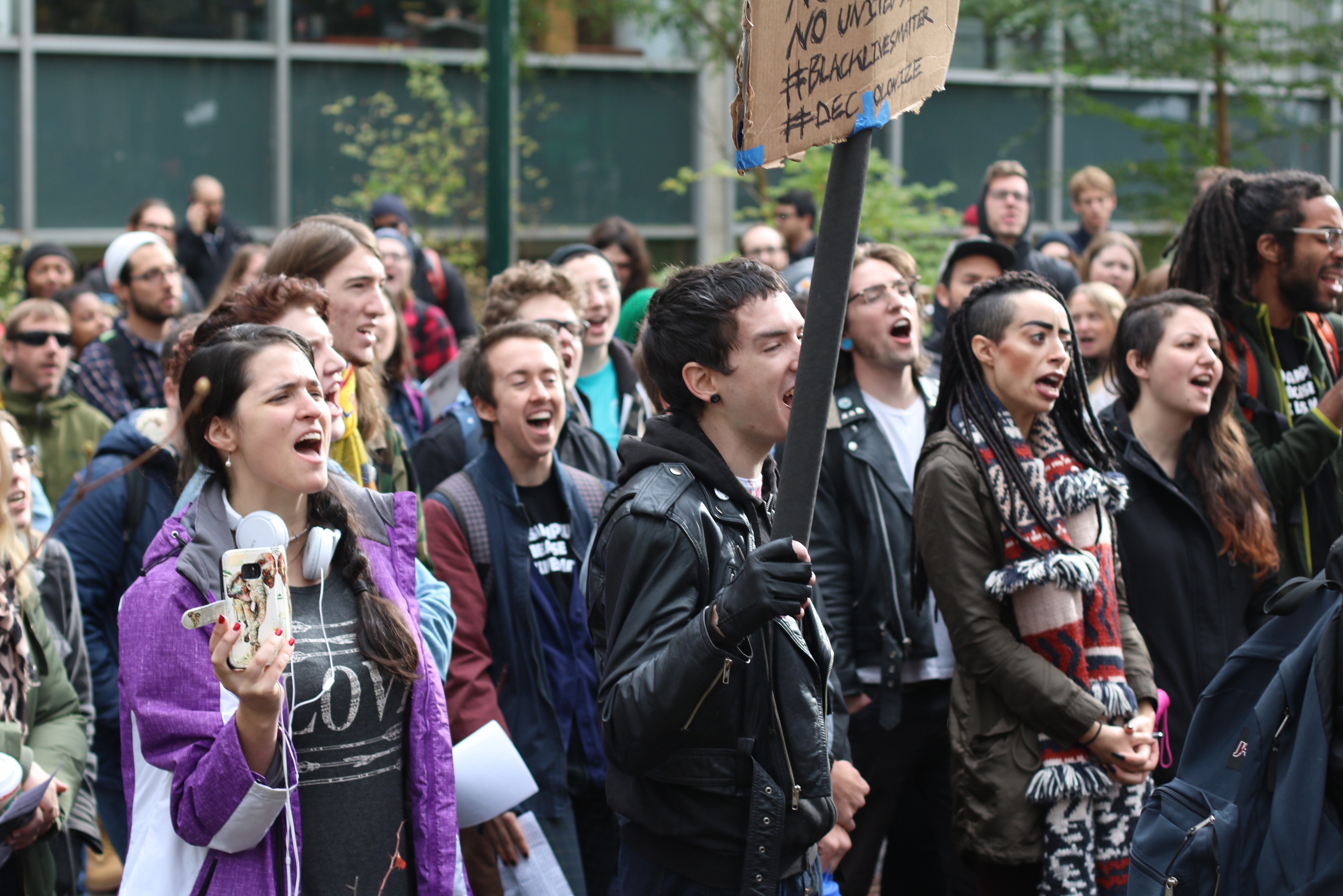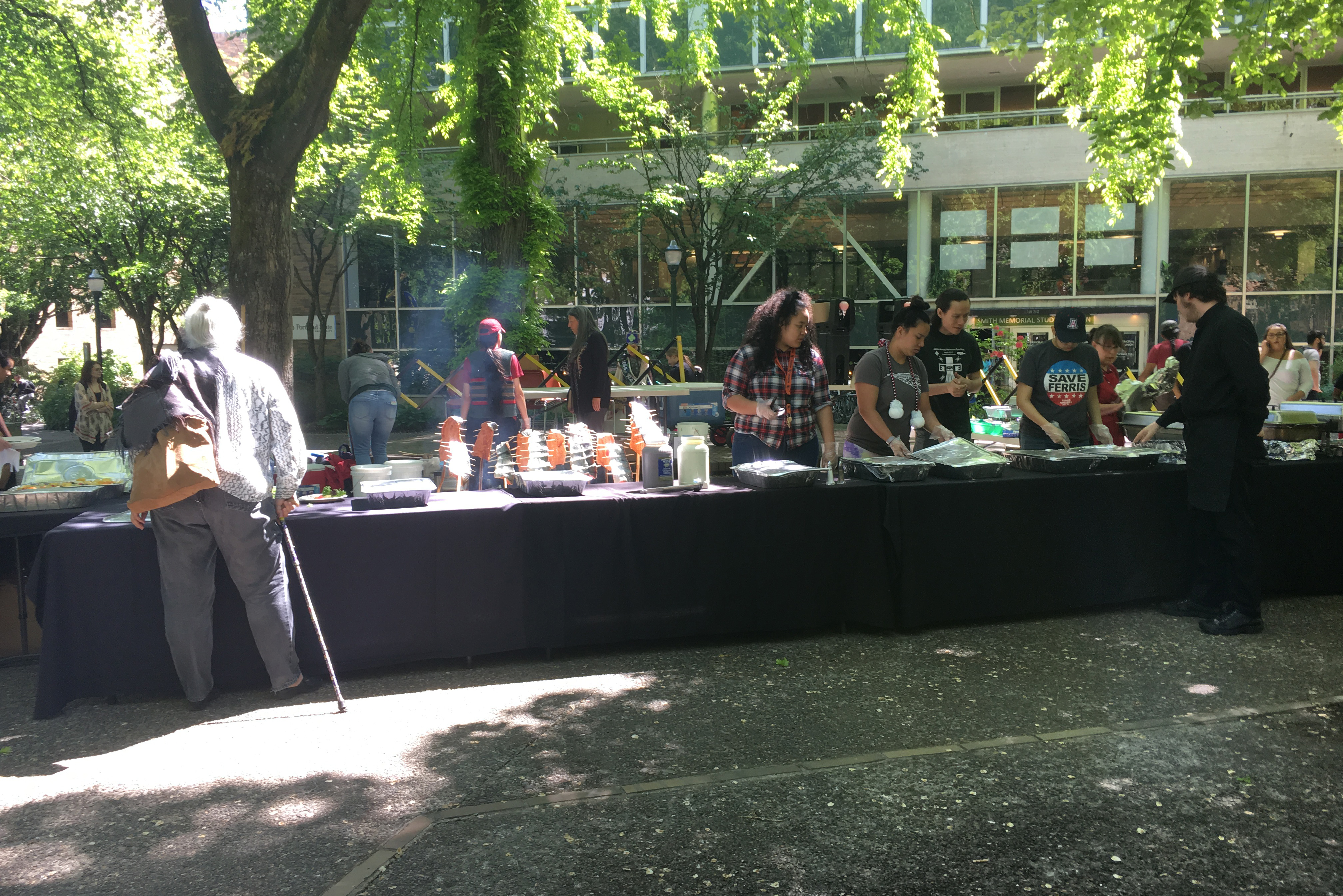Stripper
\ˈstri-pər\ noun;
1 : a performer who removes his or her clothing in a sexually exciting way
: a dancer who does a striptease
You can barely throw a microbrew in Portland without hitting a strip club: Our city holds the highest number of strip clubs per capita in the United States. There is approximately one venue for every 11,286 residents. If you’re a local, this isn’t news—and if you haven’t tried dancing for a living already, you have probably considered it a viable option; especially with the rising cost of living and education.
Recently unemployed, I wanted to consider my options as to what jobs I could work while in school that would be the most lucrative, schedule friendly and easily obtained. What were the pros and cons of dancing? Was stripping to “pay off your loans” a stereotype? I decided to find other Portland State students who dance to find out.
Stigma
\ˈstig-mə\ noun;
1 : a set of negative and often unfair beliefs that a society or group of people have about something
In Greek and Latin, a stigma was a mark or brand, especially one that marked a slave, so a stigma marked a person as inferior.
Out of the 16 students I found at PSU who work as professional dancers, only two were willing to go on record about their stripping occupations. A common boundary I found was that many strippers are tired of being questioned and judged because of their jobs and are unwilling to justify their decision.
“Why do strippers have to constantly defend stripping to non-strippers about the world of strippers?” wrote a dancer who uses the name Mmmmeadow.
“I, a stripper, can confirm that the world of stripping can be just as boring as a desk job or just as drug-filled and toxic as being a barista at Starbucks,” Mmmmeadow continued. “It’s your character, not your job.”
Another reason many students choose to avoid talking about their professions is to avoid judgment from peers, staff and family. They want to avoid being fetishized outside of their workplaces and protect their safety and personal boundaries by leaving the dance persona at work.
The same stigma that allows people to judge and criticize can also cause undue shame for dancers and a fear of speaking openly or even proudly about their profession.
More importantly though, with any job that one has while attending school, building a network of support around your goals requires transparency and accountability—a luxury our culture sparingly gives to any sex worker.
Consider the community’s role in encouraging students to pursue their educational goals: Are we making exceptions for discrimination in regard to strippers? Have we allowed our personal beliefs involving sexuality to hinder the encouragement of other students? If so, does this help us feel better about the way we see ourselves or the way we want others to see us?
Asking ourselves these questions may be an important factor in understanding the perspective of the dancers interviewed for this article and why they asked to remain anonymous.
My first step was finding out how many students actually dance. Through the dance scene grapevine I found James*, a current PSU student who recently retired after stripping for three years at Silverado.
When asked about the existence of other student dancers he said, “Surprisingly, yes. There were four other PSU students who I danced with, [including] a student who was getting a master’s at Pacific, a student from Reed, and a student from Clark College.” James continued, “I’d say a majority of the dancers were students, or at least it was a lie they made up to get more tips.”
When searching for a list of strip clubs I came across Xoticspot.com, which acts as a social media platform or a “Yellow Pages” of strippers. The number of active strippers listed in PDX alone came to 1,387. In sampling 100 users, the average age was 25 years old, leading me to speculate that the number of students dancers could be far larger than imagined.
Mary’s Strip Club was the first of many stops in my search for other students. This wasn’t my first rodeo, however, so I knew that sitting at the rack and tipping well would be the best way to ask questions.
Rochelle* was on her way off the stage when I introduced myself and asked for an interview. When asked if she was a student or if she knew of other student dancers, Rochelle replied, “I just graduated from college actually. I have a Master’s in Psychology [from PSU]. There are lots of women in college who dance around here.”
Spyce, a recruiter of PSU students, was bound to be a gold mine for fellow students due to their hiring of dancers who are not yet 21. Spyce is also one of the few strip clubs in PDX where the dancers do not remove their panties.
While ordering drinks I asked the bartender, Melissa*, for her experience regarding students. “We have lots of college students who come to dance here,” she said. “I’ve been working here for over seven years and it’s definitely a common thing.”
“Most girls I see though, just pass through,” Melissa said. “There’s not a lot who stick around.”
The next venue, Casa Diablo, is often referred as Portland’s wildest strip club or simply the “infamous vegan house of sin” by their website.
Accompanied by a female friend, we spent the night admiring the athleticism of the dancer’s pole tricks, the variety of attitudes each dancer personified, and the amount of boldness it would take to be so overtly erotic in a packed room of mostly males.
Casa only allowed an interview with the purchase of a lap dance, so with four drinks and $200 between us, we picked the sweetest and most outgoing dancer we saw on stage.
After polite introductions we began asking our dancer, Crystal*, about her dancing experience and if she worked with any students. “A lot of girls who are in school that start stripping realize how much more they make dancing, and it makes their degrees seem pointless,” Crystal said. “And so, they just drop.”
At Club 205, the dancers were also very sweet, offering nearly three hours of conversation in between dance sets.
“There are definitely girls who are in school and who dance at night to support themselves,” said Carissa*, a Club 205 dancer. “I’m not a student, but there are some here tonight that I can show you!”
Another dancer, Jasmin*, said, “I see a lot of girls who dance and go to school, but they usually quit dancing after a couple years to focus on class.”
Upon asking student-dancers how they decided to start dancing, their answers were fairly similar: schedules, lifestyles, and the need to support themselves.
“My friend was telling me about how this guy was a dancer and how much money he made doing it,” James said. “At the time I was pretty broke, so I entertained the idea.”
“That weekend, a friend and I went to scope the place out,” James explained. “I didn’t realize it at the time, but I went during Pride, so it looked like the dancers were pulling in a grand a night. After that, I decided to audition and quickly realized that most nights I make a fraction of what I witnessed.”
James’ introduction was nearly identical to another PSU student, Eric*. “When I first moved to Portland I didn’t know anyone and had just started school,” Eric said. “It seemed like a lot of fun and like they made good money.”
“I got all ready, shaved everything and started working out more,” Eric said while remembering his first night auditioning. “It felt really weird and I was really self-conscious. That part never got better for me.”
Stag, a male strip club with a body-positive “bear” and “cub” culture, was more difficult in competing for the dancer’s attention. Upon discovering that many male strippers identified as being straight, Eric offered an interesting insight: “A lot of them use their job as a way to hook up with women.”
“For a long time, we weren’t even allowed to give lap dances to women,” Eric explained. “[Not until] Stag opened, where they let anyone buy lap dances, and it took a lot of business away from the club.”
“It was so competitive for money and attention,” Eric said. “Some guys would just sit there and not talk to anyone and be only focused on getting laid or just waiting to get on stage.”
It’s not a surprise to hear how competitive dancers can be with one another, especially because dancers are commonly asked to pay stage fees in order to work. This is due to the fact that they are employed as independent contractors, therefore waiving the option of hourly pay. Clubs may also require dancers to tip out security, bar staff and makeup artists if provided.
A large difference in earnings appeared to affect the longevity of a dancer’s career depending on if they were male or female.
Female strippers reported a much higher pay than the men interviewed, although they wouldn’t admit to an average take home. Crystal reported she and other dancers made “a couple grand” every weekend.
Eric reported an average of $80 per night and disagreed with the idea of male stripping as being a lucrative means to making money as a student.
“When I started I would make an easy $2,000 working 20 hours a week,” said James. “On top of that, random guys would pay my rent, pay my bills, take me to dinner, take me shopping. Building those kinds of relationships are mentally exhausting.”
Both Eric and James decided to eventually leave their stripping careers. “Academics are my primary concern right now,” explained James. “While the flexibility in the dancing schedule can be beneficial most of the time, I really dislike getting home at 3 a.m. and waking up at 8 a.m. for class.”
Eric left for similar reasons but added, “I am just too self-critical. I just put too much pressure on myself to look the way I wanted and it got to be too much.”
Regarding how strippers felt about their jobs and how they are received by the public, both male and female students expressed similar sentiments. All reported feeling the pressure of being stigmatized and the need for discretion.
A 2015 article by a University of Michigan student called “Confessions of a College Stripper” states: “It is easy to believe that being a dancer is degrading and shows that you have no self-respect and low self-esteem. I find the experience of being a stripper very empowering because instead of getting catcalled on the street, you are instead taking control of your sexuality and choosing what you want to do with it.”
“A lot of people just assume that all strippers are drug addicts and prostitutes,” Carissa said. “I work full time and I don’t even drink.”
“Girls who are using drugs or selling themselves don’t last here, or anywhere, very long,” Carissa added. “Most of us have boyfriends or husbands and families. It’s just a job and we live normal lives.”
I asked Carissa if there was any truth to the stereotypes, suggesting the possibility of them existing for a reason. “You know there are clubs where some of the girls are shady,” she responded. “You just have to be selective and careful about your environment.”
“Society has this negative impression of sex workers that is deeply rooted in systemic sexism,” James said. “It is difficult for me to provide a decent perspective since male dancers don’t experience the same stigma that female dancers do. At the end of the day, we are there to make money, just like everyone else at their respective jobs.”
James continued to explain his experience, mentioning negative stereotypes associated with strip clubs. “I’ve seen guys be pushed to their breaking point. The profession can be empowering at many times, but it also attracts individuals who are exceptionally vulnerable.”
“I’ve seen guys develop debilitating drugs habits, I’ve seen guys struggle with depression, I’ve seen guys resort to suicide, and I’ve seen guys place their entire self-worth on how much money they made that night,” James said. “For some of the guys I’ve worked with, it is the only viable option they think they have.”
A recent Ph.D dissertation published by the PSU Urban Studies department found that many female dancers manifested issues in their personal relationships due to their jobs. Reported symptoms included hostility towards men, difficulty with sexual intimacy and alienation from family members.
The stigma associated with being a stripper was found to make female participants more vulnerable to sexual harassment from people who expected them to always be sexually available.
A study conducted in 2005 compared female indoor sex workers (strippers) and female nurses in measuring levels of burnout and exhaustion. Results showed that strippers suffered higher levels of burnout, exhibiting symptoms of emotional exhaustion due to the lack of job autonomy, social support, negative work motivation, and the condemning treatment of their character and self-worth that is contributed from their community.
According to the same study, the amount of hours, income, or type of labor were not important influences in measuring emotional exhaustion.
PSU’s Women’s Resource Center actively advocates students seeking and accessing safety for all areas of their lives regardless of their occupations. The WRC website states, “Students participating in the sex industry often feel like aspects of their life are compartmentalized, and access to non-judgmental support and mentorship on campus is not available.”
WRC offers a Student Sex Worker Outreach Project, providing many services that include planning classes around work, or handling non-consensual disclosure of their sex worker status on campus.
I found there wasn’t a black and white answer in regard to deciding if dancing would be a good option for me. Was the money worth it for short term gain? Could I “just brush it off and have fun with it,” like the bartender from Spyce advised?
Regardless of what I decide to do, I’m grateful for the insight given to me from my fellow PSU students who participated.






